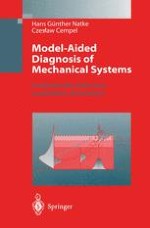1997 | Buch
Model-Aided Diagnosis of Mechanical Systems
Fundamentals, Detection, Localization, Assessment
verfasst von: Professor Dr. rer. nat. Dr. hc. Hans Günther Natke, Professor Dr. habil. Czeslav Cempel
Verlag: Springer Berlin Heidelberg
Enthalten in: Professional Book Archive
